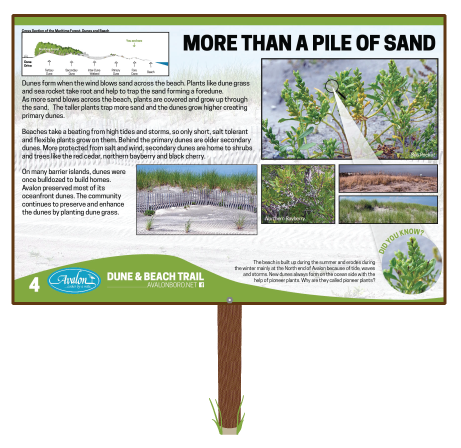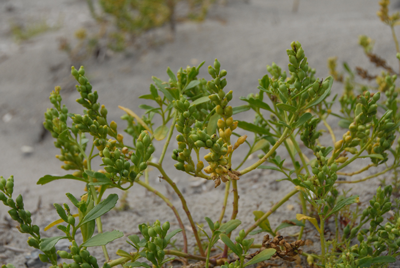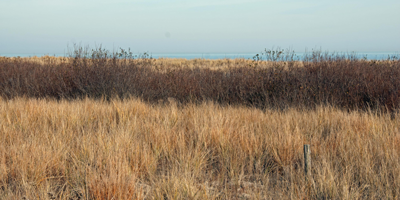

Avalon’s dune system is a natural beach ecosystem consisting of a foredune, primary, secondary and tertiary dunes. The dune system produces variable salt exposure to the plants in the dunes because of the different landforms that develop. Dunes are host to many plant and animal species. The most salt tolerant species live along the back beach and the foredune where salt spray is most frequent. As far back as the secondary or tertiary dune, freshwater springs and vernal ponds may be found. This creates opportunities for a wider variety of animals including frogs, toads and salamanders. The varying salt exposure of the dune structure allows for multiple stages of plant development and of diverse ecosystems within a confined area. This development, which often takes hundreds of years, can be seen by walking just a few hundred feet!
The intricate dune systems were originally created from the deposition of sand on the beach. But where does the sand come from? The sand that ends up on our beaches has to start somewhere. It starts as rock fragments eroding from cliffs, stones tumbling through rivers, seashells and remains of sea animals. The sand that ends up on our beaches is the oldest and strongest material that remains from these sources. As the sand gets deposited by the tides and wind, the foredunes develop. Resilient plants such as sea rocket (known as a pioneer plant) and dune grasses colonize the area. As new dunes continue to grow and protect the older dunes, plant succession begins where the first plants begin to alter the soil and deposit organic material making it possible for other plants to survive. A new community of plants replace the older ones by growing taller and blocking direct sunlight. This eventually creates a mature community that reaches an equilibrium when the heartier plants cannot access any more water or nutrients and do not develop to full potential. This ecological succession is what creates so many different, unique ecosystems in a small area.

Searocket, mature
In addition to the unique ecosystems, dunes act as the first line of defense against storms. They protect the island from erosion, especially when they are well covered with plants. Plant life helps stabilize the dunes by holding sand in place with their roots. The stronger the root system, the more stable the dune will be. As dunes persist, they continue to grow through the deposition of additional sand from blowing winds. This allows for the development of primary, secondary and tertiary dunes. Experience Avalon’s unique dune system by taking the trail to the beach. Turn around and see if you can identify where primary, secondary and tertiary dunes are located.
For Further Information

